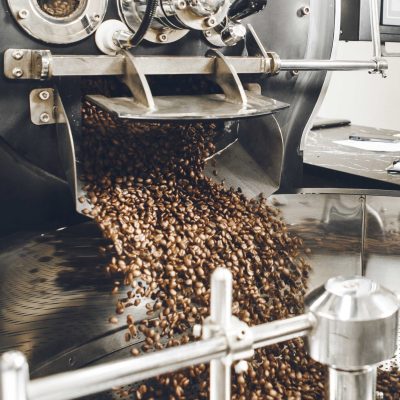Coffee roasting is the process of heating raw coffee seeds (known as green beans) under controlled time and temperature. This stage is far more than just changing the bean’s color from green to brown; it’s a complex chemical process that unlocks and develops the hundreds of flavor and aroma compounds hidden inside.
A roaster acts as both an artist and a scientist, tasked with creating the specific flavor profile that coffee lovers will enjoy in their cup.
The Three Main Stages of Roasting
Every coffee bean goes through a series of physical and chemical phases inside the roasting machine:
1. The Drying Phase
When green coffee beans (which typically contain 10-12% moisture) are introduced to the heated machine, the first objective is to evaporate this moisture.
- What Happens: The bean absorbs heat, and its color shifts from green to a pale yellow.
- Importance: This phase must be executed slowly and evenly to prepare the beans for the subsequent chemical reactions without scorching the exterior.
2. The Browning Phase & First Crack
Once the beans are dry, the temperature rapidly increases, triggering the essential chemical reactions that create flavor and aroma.
- Maillard Reaction: This reaction between sugars and amino acids is the primary source of the brown color, the coffee’s body, and its toasty or nutty aromas.
- First Crack: At approximately 205∘C (401∘F), gases inside the bean are released, causing the bean to pop with a sound similar to popcorn. This marks the start of true roasting and when the bean begins to expand significantly.
3. The Development Phase & Second Crack
This is the most critical phase, where the roaster determines the final coffee profile by controlling the duration and rate of temperature increase.
- Caramelization and Pyrolysis: Sugars continue to caramelize, creating deeper sweetness (like caramel). If roasting continues, pyrolysis (thermal decomposition) generates stronger bitterness.
- Second Crack: If the process is continued, at about 225∘C–230∘C (437∘F–446∘F), the bean cracks again with a softer, faster sound. The coffee’s natural oils are pushed to the surface, and the bean’s acidity drops sharply.
Roasting Profiles: The Three Main Levels
The duration and stopping point of the roasting process create three primary roast levels, each resulting in a distinct flavor profile:
1. Light Roast
- Characteristics: Stopped just after the First Crack or soon after.
- Flavor: Retains high acidity and the bean’s original floral/fruity characteristics (often preferred for single-origin coffees). The beans are dry (not oily) and light brown in color.
2. Medium Roast
- Characteristics: Stopped before reaching the Second Crack.
- Flavor: Provides the best balance between acidity, aroma, and body. The sweetness from caramelization is noticeable, and the bitterness is still mild. This is the most popular choice for various manual brewing methods.
3. Dark Roast
- Characteristics: Continued until or past the Second Crack.
- Flavor: Intense bitterness and a heavy, thick body dominate. The original characteristics of the bean are often masked by the roast flavor. Oil is clearly visible on the bean surface. This profile is frequently used for espresso or coffee mixed with milk.
The Final Steps: Cooling and Resting
Immediately after the desired level is reached, the beans must be rapidly cooled to stop the roasting process and prevent scorching.
Following cooling, the freshly roasted beans must undergo a Resting or Degassing period of one to seven days. During this time, the beans release trapped carbon dioxide created during roasting. This resting process is essential for the coffee’s flavor to mature and to ensure the brew is optimal—not overly sour and at its aromatic peak.
Coffee roasting is the fusion of art and science that determines whether a coffee bean will become an ordinary drink or an extraordinary one.
